#IN HER QING DYNASTY CHANGYI
Text

her ba sing slay
#id in alt text#avatar the last airbender#atla#katara#art#mart#KATARA FASHIONISTA💗💗💗#IN HER QING DYNASTY CHANGYI#THAT TOOK ME FUCKING FOREVER TO DRAW………#anyone who has the patience to draw that much detail in one sitting is a god tbh#I literally drew this over a period of many months#so like. it BETTER be appreciated dammit#katara kataraaa most beautiful girl in the world#katararaaaaaa💗💗💗
1K notes
·
View notes
Text
Cultural Fashion: Katara's Ba Sing Se Dress

Katara's Ba Sing Se dress is inspired by changyi robes (氅衣), which were full-length gowns worn by Manchu noblewomen during the Qing Dynasty (1644–1911). Characteristics of changyi include high slits on both sides of the dress, prominent trim along the openings of the robe, and a rounded cross collar (pianjin/偏襟). Around the beginning of the 20th-century, standing collars and more fitted silhouettes also became common on changyi and other Manchu women's clothing. Overall, Katara's Ba Sing Se dress possesses many characteristics of a late Qing Dynasty changyi.
However, similar to her headdress, her robe isn't 100% historically accurate. The standing collar doesn't appear to be directly attached to the pianjin opening and her sleeves appear to be modeled more after hanfu than qizhuang (Qing Manchu clothing). Nonetheless, her design still alludes to a very specific period in Chinese fashion history, rather than simply being a generic "Asian-esque" dress. Plus, the design is just lovely!
Fun Fact: The cloud pattern on Katara's dress is known as xiangyun (祥雲) or "lucky clouds" in Mandarin. Clouds are considered auspicious imagery in Chinese culture due to the Mandarin word for cloud (yún / 雲) sounding similar to the Mandarin word for good fortune (yùn / 運).
Like what I’m doing? Tips always appreciated, never expected. ^_^
https://ko-fi.com/atlaculture
653 notes
·
View notes
Photo
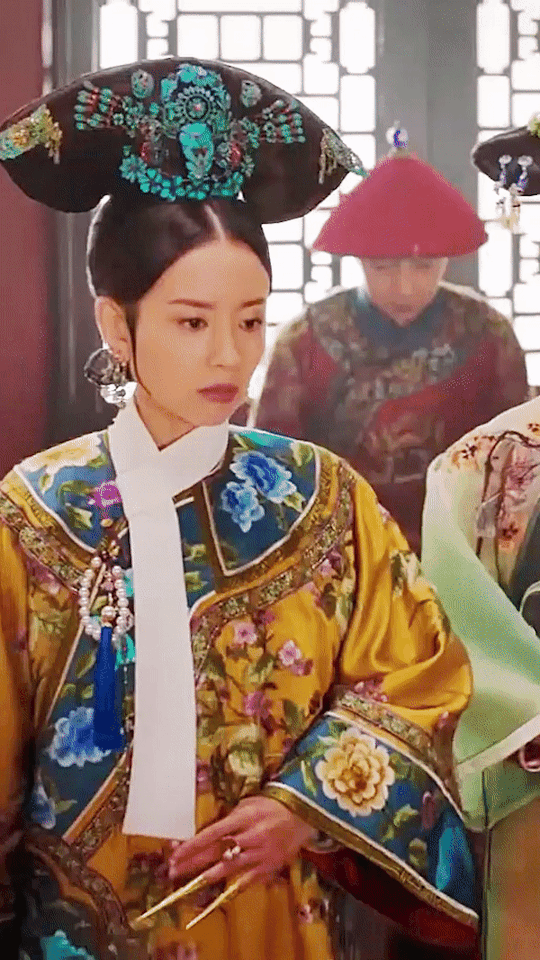
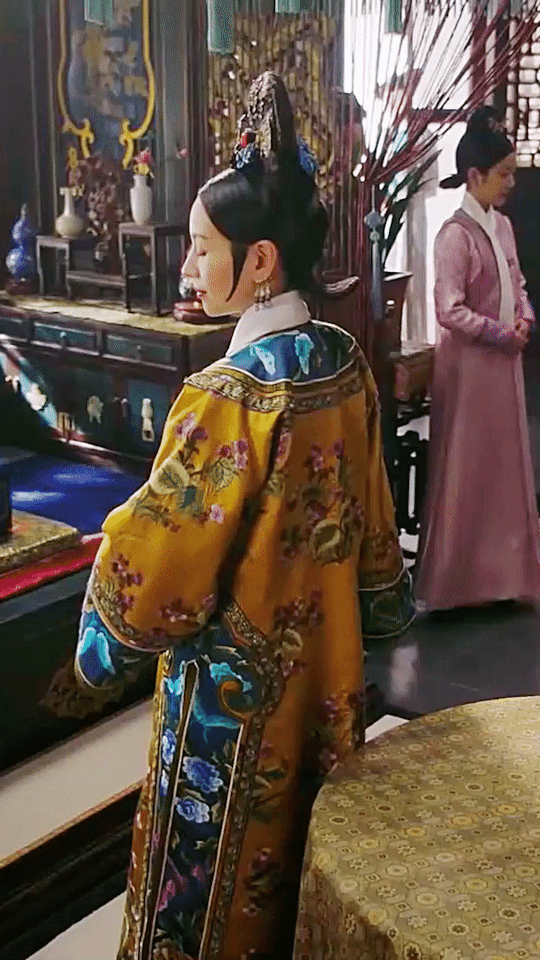

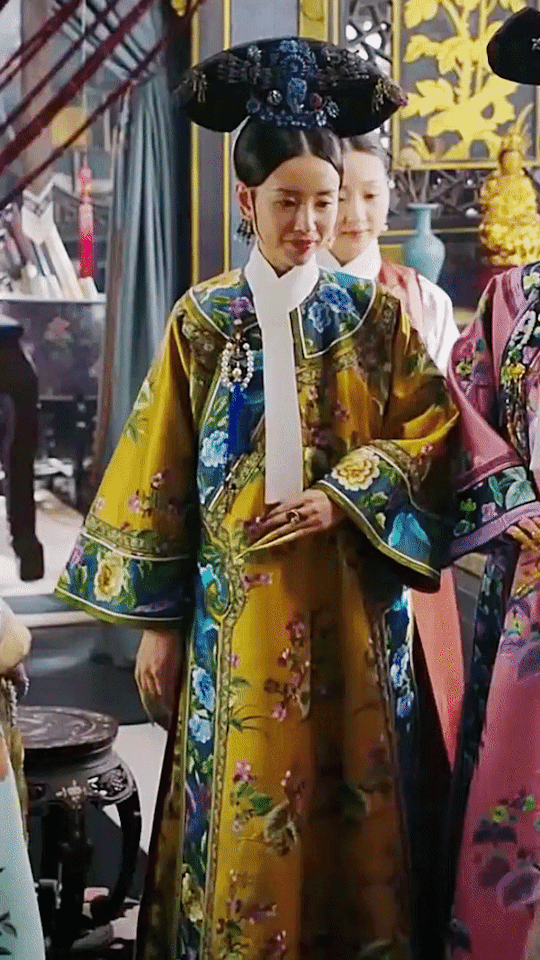
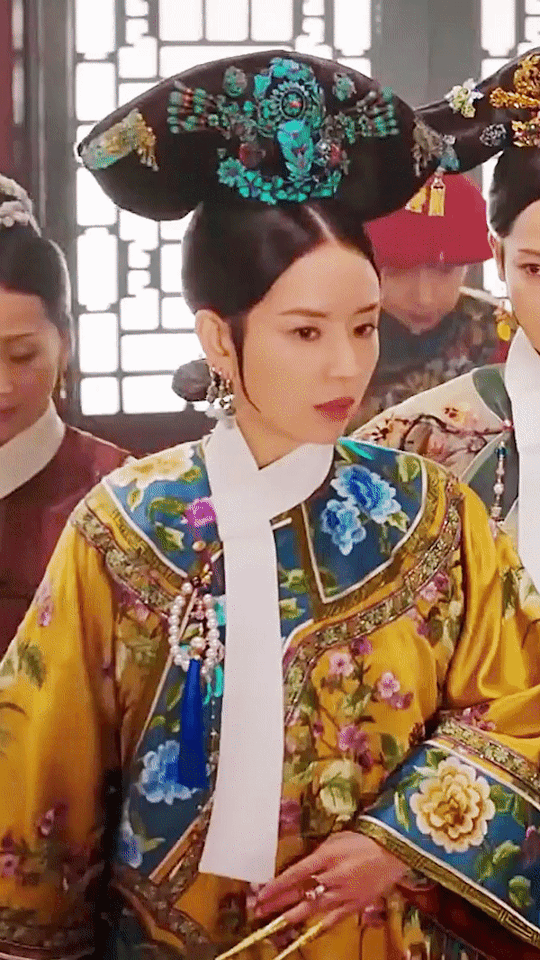

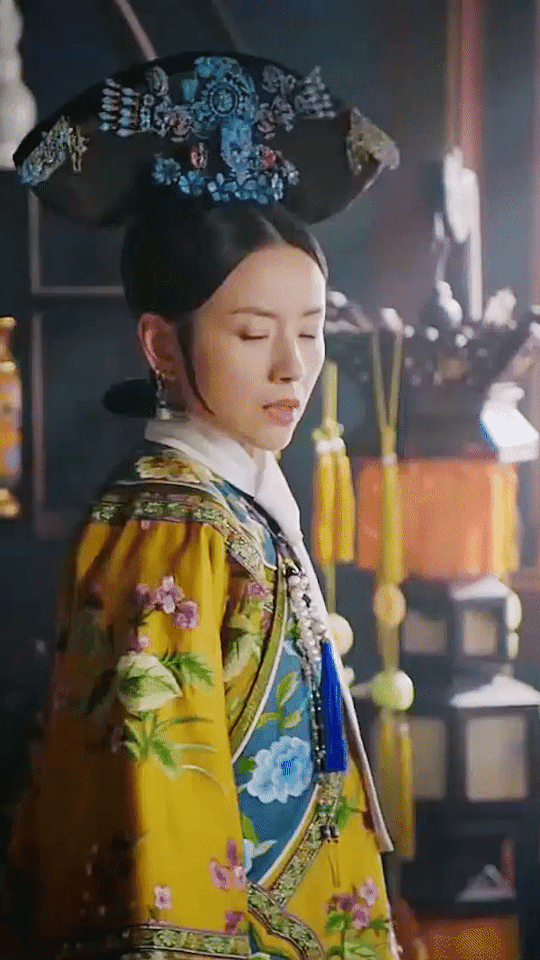

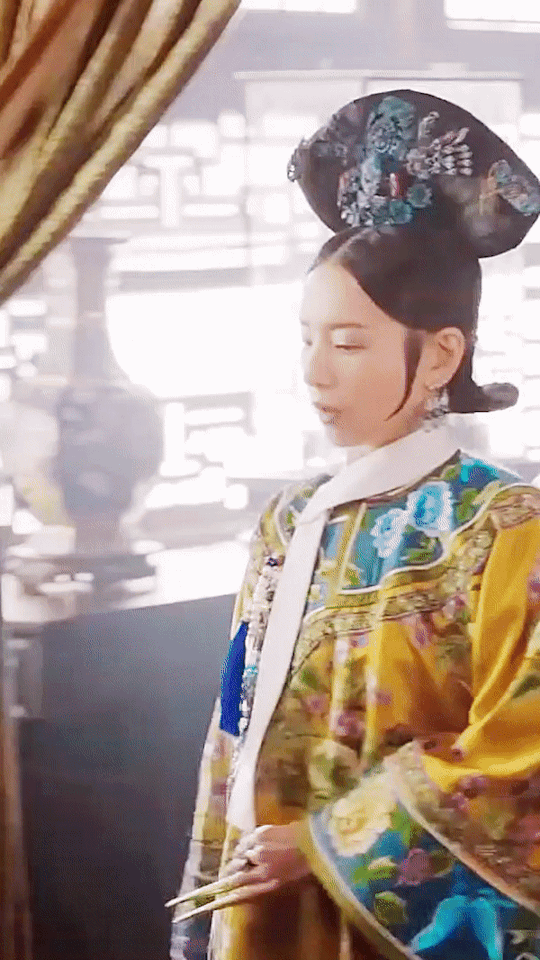
legend of ruyi: outfit appreciation
#legend of ruyi#asiandramanet#cdrama#cdramanet#cdramaedit#gifshistorical#weloveperioddrama#perioddramaedit#ruyi zhuan#ruyi's royal love in the palace#dynasty: qing dynasty#costumes: legend of ruyi#costumes: all#langhua looks#stuff:mine#i love this changyi of hers#stuff: legend of ruyi
75 notes
·
View notes
Text
History of Chinese standing collars (part 1: Ming & Qing)
So, a lot of people nowadays refer to a certain type of standing collar as a “Mandarin collar” but I'm not sure if that’s legit, because standing collars throughout Chinese history looked different. I was confronted by this topic when I was writing my post on 1950s Chinese fashion and felt like I had to make a separate post. I’m gonna do a quick break down of all the different types of standing collars in historical Chinese fashion from the 16th century to the present and how they developed.
Ming Dynasty (1368-1644)
The first mature 立领 liling standing collars were applied to women’s robes in the late 15th/early 16th century. Before any garment with a standing collar was invented, both men and women in Ming China wore garments with either a 圆领 yuanling round collar, 直领 zhiling parallel collar or 交领 jiaoling crossover collar, with crossover collars being the more common in womenswear.

Source here
Early Ming Dynasty portrait of a lady in a crossover collar robe.
The development of a standing collar was in large part thanks to the invention/adoption of the 子母扣 zimukou metal clasp button. I wonder why the fabric knotted buttons used on round collar robes were not used on standing collars in this period? They were awfully similar to the pankous of later. Anyway, at one point in the 15th century, some women thought it would be cool to add zimukou to their clothes and it resulted in this (they were also used on 比甲 bijia, 半臂 banbi and 短衫 duanshan but those are irrelevant to collars):
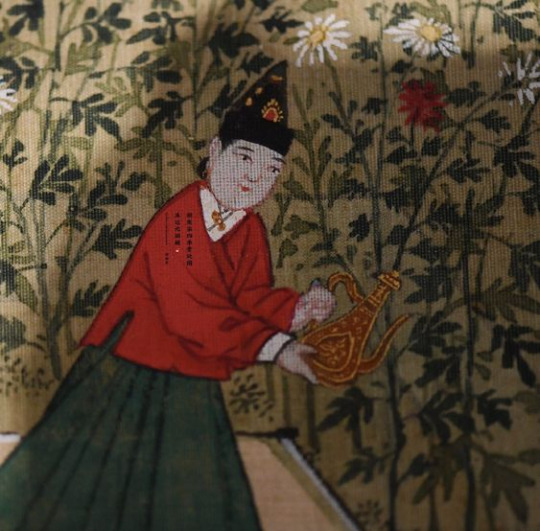
Source here
Part of 明宪宗元宵行乐图 (a painting depicting various Lantern Festival activities at the court of Emperor Xianzong), 1485. This lady is wearing a crossover collar robe with a zimukou at the middle.
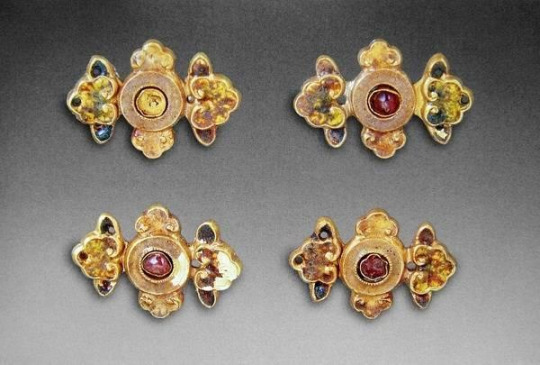
Source here
Modern reproduction zimukou. You could buy these for cheap on Taobao if you want to sew your own Ming style hanfu btw.
In the 16th century a fashion revolution took place in China: the standing collar, which came out of nowhere, began to suddenly dominate women’s clothing. This OG Chinese standing collar was very tall and form fitting, usually covering all of the wearer’s neck. It had sharp, rectangular edges and was closed by two zimukou, one placed at the bottom of the collar where it meets the bodice and another slightly above, not reaching the top of the collar. An important feature that set this apart from the collars of the 20th century is that it was unstiffened and made of the same fabric as the robe, meaning it was soft and could be worn with the top bit folded over, showing the lining which could be of a contrasting color. For archival purposes let’s call this collar style 1.
There are various theories as to why the standing collar was invented, e.g. because of colder climate during the little ice age, which peaked in the late 16th/early 17th century. Methinks it was just a fad which stayed.
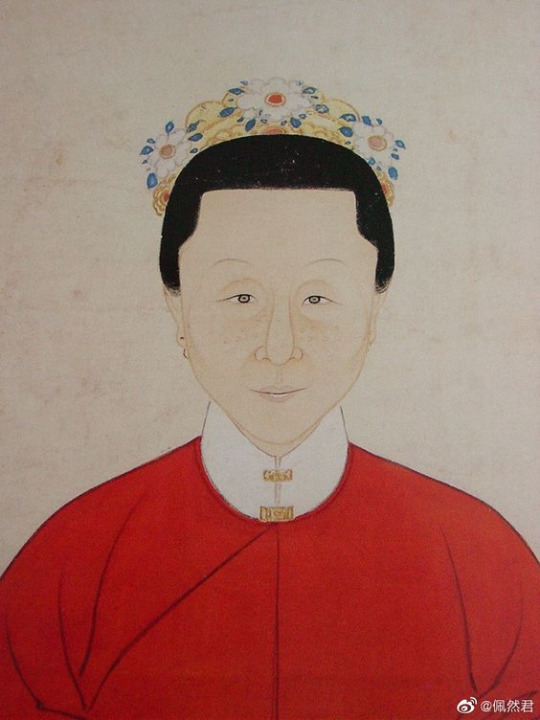
Source here
Late Ming Dynasty portrait, collar style 1.
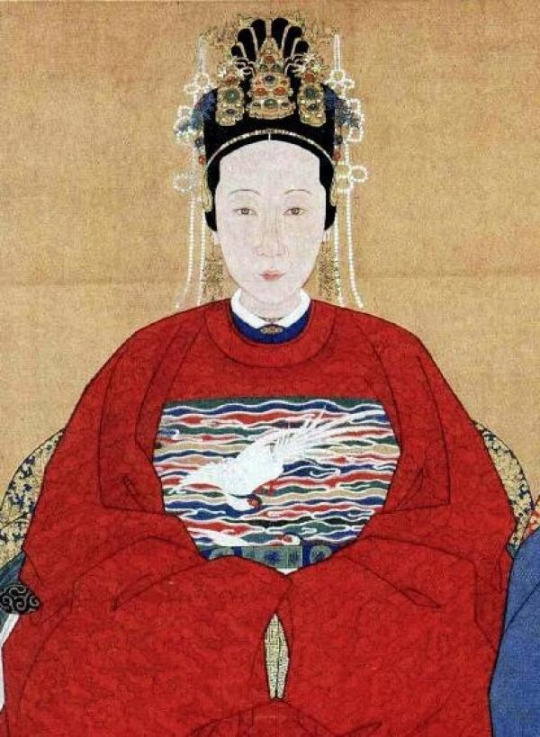
Source here
Late 16th century/early 17th century aristocratic lady wearing a standing collar robe underneath a round collar robe. The top of her collar is folded over. Collar style 1 variation 2.
Qing Dynasty (1644-1911)
This style of collar became the norm for Han Chinese women’s fashion in the mid to late 16th century and stayed that way throughout the 17th and 18th centuries. While the clothing silhouettes and accessories changed, the shape of the standing collar remained the same.
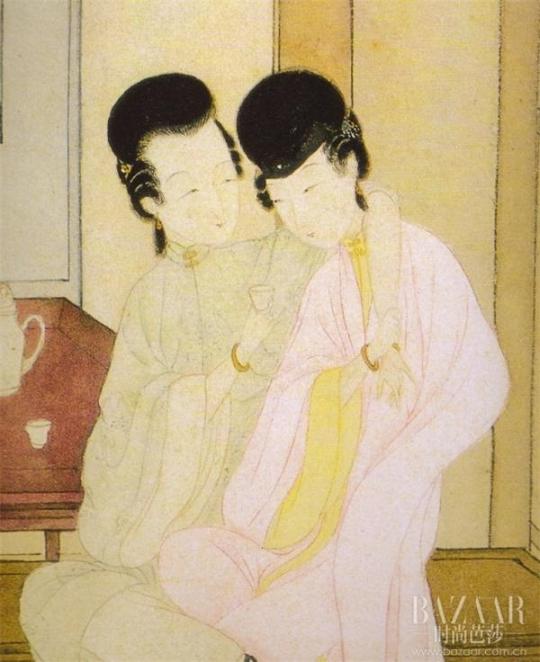
Source here
Late 17th century illustration for pornographic novel 肉蒲团 (1657). Collar style 1, but it became fashionable in the 17th century to have rows of piping around the neck for each button, so variation 3. Oh and wlw pride come throoouuuugh
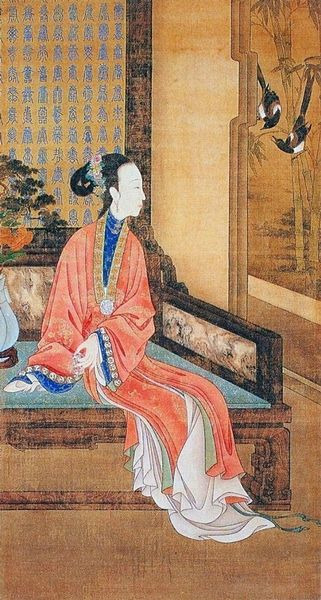
Source here
Early 18th century court painting, collar style 1 variation 3.
At some point in the late 18th century Han women decided it would be cool to use 盘扣 pankou, this fabric braided/knotted button of Manchu origin (more on Manchu dress later) on their collars instead of zimukou. The decoration also became more extravagant, with often rows of thick binding, piping or trim, corresponding to the decorations on the rest of the robe. It’s also slightly shorter, the upper button being at the very top of the collar. Let’s call this collar style 2.

Source here
(Presumably) late 18th century reverse glass painting showing collar style 2. The late 18th century deserves more attention, it’s such an important transitional period but also charming in its own way. This is true of European fashion of the period as well, I honestly love both places in the late 18th century.
In the beginning of the 19th century, the fashionable collar shape suddenly changed for some reason. It became extremely low, approximately only 1-2cm tall, only tall enough to accommodate one button. It still had crisp, rectangular edges. You could say this is another variation of collar style 2 but it is so iconic to the 19th century I think I’ll call this collar style 3.

Source here
Reverse glass painting ca. 1830. Han lady wearing a robe with collar style 3.
Now a brief look at Manchu womenswear. I am not an expert on Manchu historical fashion so tell me if I’m wrong. So the Manchus, who were apparently a confederation of Jurchen tribes from the area in what is northeastern China nowadays, invaded China successfully in the 1640s and remained the rulers of China until 1911 when they were replaced by the Republic of China. Throughout most of the Qing Dynasty Manchu women wore collarless robes, it was not until the mid 19th century that some Manchu women started to wear detachable collars to emulate Han women’s fashion, and not until around 1908 (!) when standing collars were actually added to their gowns themselves. Yes, period dramas did Manchu women dirty, poor gals have been dressed in the wrong costumes this, entire, time. The misrepresentation of Manchu historical fashion in the media in general is just fucking infuriating, but well, topic for a future post.

Source here
Late 17th century/early 18th century portrait of a Manchu lady. She is wearing a 衬衣 chenyi, a robe with straight sleeves, no slits and closed at the right side. It’s a casual gown worn for everyday activities. Her chenyi is collarless and the collar is closed by binding.
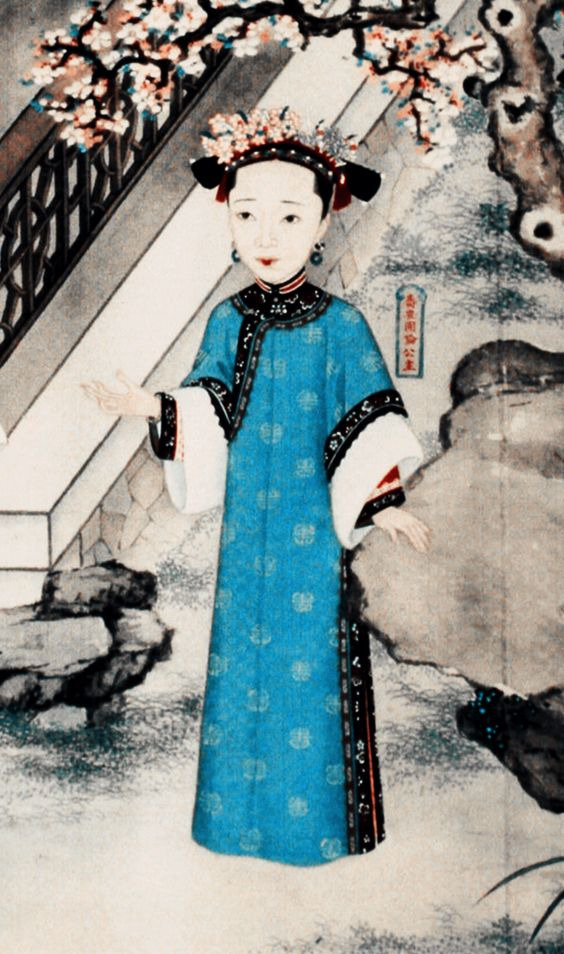
Source here
1840s/1850s court gown. She is wearing 氅衣 changyi (the bottom part of the first character should be 衣 not 毛 but this character is so obscure that it literally DOES NOT EXIST in the Chinese language anymore omg), a more elaborate style developed in the early 19th century with slits down both sides and wide trims along the collar, cuffs, side closure, side slits and hem. I have yet to see an extant example with a standing collar, all the changyi from the 19th century I’ve seen in museum collections are collarless, so the collar seen in paintings must’ve been detachable. Maybe some Manchu women liked Han women’s fashion and wanted to wear a detachable collar. I have, however, seen Manchu women’s vests and jackets with standing collars. These were similar to late 18th century Han women’s collars, so collar style 2.
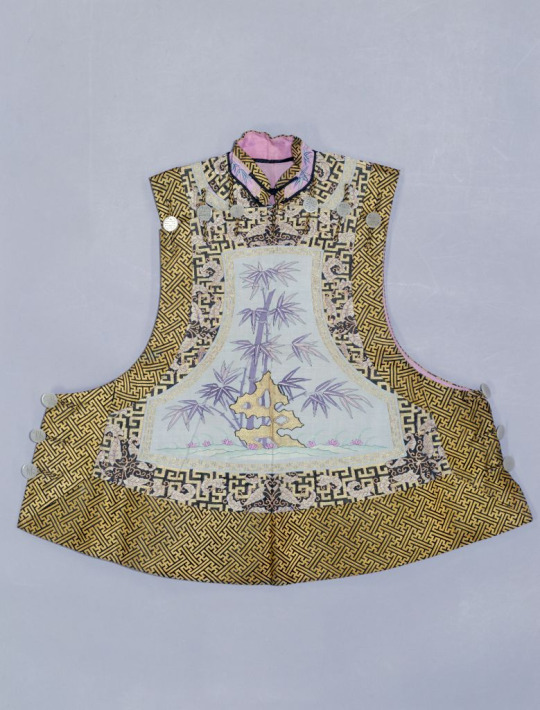
Source here
1890s/1900s women’s vest with collar style 2.
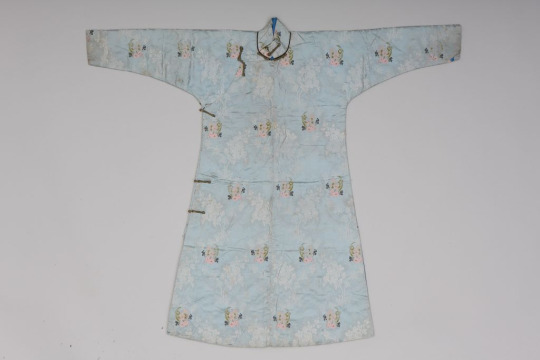
Source here
Ca. 1908. Chenyi with standing collar. If the passage of time is still not clear, notice the Western fabric used. Collar style 2.
At first glance this might look like a cheongsam but it is not. Chenyi did not have slits down the sides, unlike most 20th century cheongsam. It may have been a source of inspiration for cheongsam though, as I have explained in one of my 1930s posts, although the more obvious prototype for cheongsam was the changyi with slits and standing collars.
Let us now turn our attention to Manchu menswear, which is where things get complicated. In the 17th and 18th centuries, the Manchu riding habit, 行服袍 xingfupao, was a form fitting calf length robe with form fitting long sleeves and 马蹄袖 matixiu “horse hoof cuffs”, closed at the side with pankou. It was constructed in the same method as Han Chinese clothing. This original Manchu robe was collarless----I cannot stress this enough. The Manchus did not come barging into China wearing robes with standing collars goddamnit, get your facts right period dramas.

Source here
Portrait of Emperor Kangxi in a xingfupao. This is from the early 18th century already but the style didn’t change much so you get the idea. I love this color btw I think he looks great in it.
The xingfupao was an informal riding habit and only one small part in the gigantic system of Manchu court dress, the rules of which are well documented but I don’t bother to look them up. If you would like to do that, Google 大清会典. At one point in the early 18th century some Manchu dudes decided it was cool to add a collar to their xingfupao (like... Han women??) and it resulted in this:

Source here
An early example from the Kangxi era (1661-1722), a xingfupao with a standing collar of a contrasting color. The hem is detachable for horse riding (horse riding was an important aspect of Manchu culture and that influenced many of their fashion decisions). Judging by the fur lining I assume the standing collar was added for warmth in winter? I also saw some xingfupao with fur trim attached to standing collars so maybe that was the purpose.
Standing collars on xingfupao was constructed in a similar way to Han women’s collars, with rectangular edges and closed by two buttons. Pankous, which were unique to Manchu dress, were used instead of the Han zimukou. It appears that this collar was also soft and unstiffened, so it could be worn with the top bit folded over like in ye olde times (the 16th century). It’s important to note that xingfupao with a standing collar were not common at all, maybe a 1/20 probability to see in museum collections. Construction wise it’s similar to collar style 2 but it appeared earlier and was exclusive to menswear, so let’s call it collar style 4.

Source here
Qianlong era (1735-1796) portrait, xingfupao with standing collar of the same color folded over. Collar style 4 variation 2.
Another garment with a standing collar was the dress of the officials, known by white people as “Mandarins”. From the artworks and photographs I’ve seen, the collar only appeared in the outfit with a 行服褂 xingfugua, a button down tunic with straight, wide sleeves and slits at the front, back and sides. It was usually worn in combination with xingfupao, like how a shirt and vest are fixed combinations in European menswear. However, the collar of this kind of outfit was separate from the tunic itself. A plastron with an attached collar was worn underneath the robe and tunic (completely detachable collars were also used I think??) and the collar was buttoned from the inside. Not sure if this qualifies as a standing collar at all since it isn’t even attached to the robe itself, but anyway let’s just call this collar style 5.
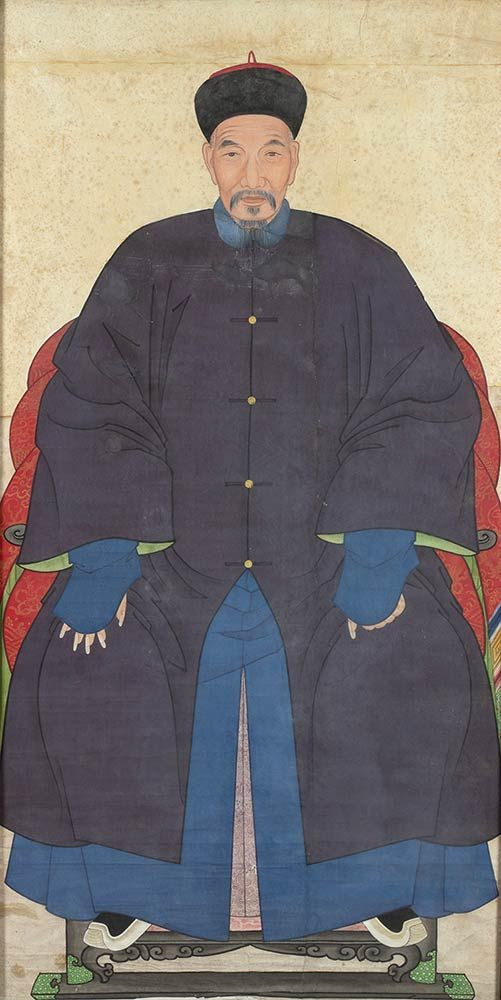
Source here
19th century portrait of an official. He is wearing a blue xingfupao, an indigo xingfugua and a blue detachable collar; a standard ensemble (well he’s also wearing pants and boots and stuff but that’s not the focus here). Collar style 5.
Oh I forgot to mention, after the Manchus took over China, they enforced their dress code on Han Chinese men but not Han Chinese women, so in the Qing Dynasty Han and Manchu menswear were one and the same but Han and Manchu womenswear were not.
I’ve only been talking about court dress so far, educated/well off civilian Han men would wear 长衫 changshan, a floor length robe, sometimes with a 马褂 magua, a short riding vest (derived from xingfugua), whereas poorer Han men would wear 短打 duanda, a short button down shirt, and pants. Well people who wore changshan also wore pants underneath but they’re not visible. All men wore pants tbh (incoming tangent), a while back when Harry Styles in a dress (which I stan) was making the rounds on social media some well meaning people were trying to find historical precedents for men wearing dresses and they named Chinese historical clothing as an example. I just wanna say, while I appreciate the sentiment, the harsh reality was that historical Han Chinese fashion was extremely gendered (except for a few brief time periods and a few select garments). Pants were reserved for men and skirts for women, the long gown like garments seen on men in historical portraiture were all robes, not dresses; you wouldn’t consider a long coat or bathrobe a dress nowadays, would you? Men always wore pants as undergarments while women wore petticoats. However I think that’s great for illustrating how our perception of whether a garment is masculine/feminine could change over time and that gender is socially constructed. Back to the main topic, to my knowledge, magua never had collars because it was a vest, changshan commonly had collars and duanda sometimes did too. I’m not sure when the standing collar began to appear on changshan, maybe when the court xingfupao gained collar style 4 it stuck in civilian fashion, maybe it was some point in the 19th century.
Anyway, fast forward to the late 19th century, the men’s changshan had a tall standing collar but again it was different to everything we’ve seen so far. It was exceptionally tall and had a smoothly tapering edge closed by only one pankou at the bottom. This resulted in a huge v shape gap down the middle. It’s still unstiffened but because of the lack of a rectangular edge it couldn’t be worn folded over. Let’s call this collar style 6.

Source here
Late 19th century/early 20th century portrait of a man. Changshan with collar style 6.
Let’s finish this part with Han women’s collars in the 1890s and 1900s. Around this time Han womenswear began to modernize and become simpler, but that trend did not apply to collars: the collars of Han women’s robes suddenly became unnaturally tall. They were so tall that they touched the wearer’s cheeks and couldn’t be closed at the front at all, kind of resembling Regency era European men’s collars?? This style of collar was oftentimes called 元宝领 yuanbaoling, ingot collar, or 马鞍领 ma’anling, saddle collar, after the object it resembles. Let’s call all of these tall collars that touch the wearer’s face collar style 7, but bear in mind these had a lot of variations.

Source here
Photograph from the 1900s. This could be categorized as a cursed variation of collar style 6 judging from how it only has one pankou and a tapering edge instead of a rectangular edge. But like, belle époque Chinese collars are a whole other species, so let’s comfortably call it collar style 7.

Source here
More collar style 7 representation. This collar style will never stop being funny to me, like just look at it it’s so tall.
So, in summary:
Collar style 1: OG Ming Dynasty standing collar, in fashion from the 16th to mid 18th century. Tall, unstiffened, rectangular edges. Closed with two zimukou. Could have piping (17th & early 18th century). Could be worn with top bit folded over (16th & early 17th century). Worn by Han women.
Collar style 2: developed from collar style 1, popularized in the late 18th century. Medium height, unstiffened, rectangular edges. Closed with two pankou/other fabric buttons. Commonly has binding, piping or trim. Worn by Han women in the late 18th century, partially adopted by Manchu women in the late 19th century.
Collar style 3: developed from collar style 2, exclusive to the 19th century. Extremely short, unstiffened, rectangular edges. Closed with one pankou. Commonly has binding, piping or trim. Worn by Han women.
Collar style 4: collar style 2 but simpler, appeared in the late 17th/early 18th century. Tall, unstiffened, rectangular edges. Closed with two pankou. Commonly plain. Worn by Manchu & Han men.
Collar style 5: detachable standing collar, a staple of official’s uniforms throughout the Qing Dynasty. Medium height, unstiffened, rectangular/rounded edges. Buttoned from the inside. Always plain. Worn by all officials (exclusively men in this era).
Collar style 6: civilian men’s collar characterized by v shape gap at the front, I don’t know when it first appeared, some point in the Qing Dynasty. Tall, unstiffened, rounded and dramatically tapering edges. Closed by one pankou. Worn by civilian Manchu & Han men.
Collar style 7: cursed belle époque (1890s & 1900s) women’s collars that touched the wearer’s face. Extremely tall, stiffened, both rounded and rectangular edges existed. Closed by one pankou at the bottom but sometimes had more pankou for ornamental purposes. Worn by Han women in this period.
Join me next time as we dive into the Republican era where things get extra complicated.
#hanfu#historic fashion#chinese fashion#chinese history#ming dynasty#qing dynasty#16th century#17th century#18th century#19th century
344 notes
·
View notes
Text
Chapter One- “Ai Ya Ya”
Chapter One "Ai Ya Ya"~ Crimson Red
第一章 "哎呀呀" ~ 深红色
There was a beneficial and great era of my country called the Qing Dynasty, ...
When is that Wang?
It is...hm...remember Catherine the Great?
Da! Such an enlighting and heroic era, the Russian Enlightment was? She is one of my favourite bosses!
Around then...
~*~
A holy day of February, the day of the Yuanxiao Festival. Always one of the happiest and most cheerful festivals in China. People from all social rankings gathered together to spend the day, creating simple lanterns to join the emperor and his family together with the noblemen in the game the children were triggered to play each year.
China was taking a stroll before the official beginning. He would join Emperor Qianlong and the rest of the noblemen in the official start, but he didn't care. He could appear decently in a matter of seconds, in contrast with most of the fine class men. His official chaofu wasn't that hard to wear by himself even in his age he wouldn't be alive if he wasn't a country. His hair wasn't that bad, and a simple but elegant semi-ponytail would do.
Walking around the peaceful but loud scenery of Beijing and watching the people of his country happy and united made him smile and enjoy the rest of the day. Seeing everyone excited was his first and only priority. And that specific day, he always achieved it. Everyone seemed happy and strong, for his eyes...the best thing that had ever happened.
A few children trying to guess riddles to prepare for later. Women gossiping about the passengers, including himself, while they were preparing the family lantern. Men doing the last preparations for the dinner with an expression of combined tire and love. Elders play with and riddle the new generation and recall memories of their own tasks.
It was a day of joy all over China. But Beijing was the most outstanding.
China remembered he was asked by the emperor to attend his palace before the event because they had to have their usual talk before everything important for the country. All emperors seemed to be more dramatical than the other. They could barely smile. But this certain one's severe and kind-hearted personality was enough to make China like him and consider him a great ally, boss and companion.
Our protagonist arrived earlier than the supposed time of the arrangement, but a sweet and polite servant informed him the emperor didn't rush and he could wander around freely in the Forbidden City, in which he had full access since the first time as he was the country but he prefered a more common life among the simple residents with the difference that he had the financial power to live under better conditions.
He had always found the Forbidden City an interesting place, and a shame that it wasn't open to the public. The beautiful trees and majestic lakes were only available for the emperor's eyes. The temples were designed delicately and were seen ritualistically. There was almost no one giving them a purpose, other than the servants that respectfully took care of them. It was such a disgrace to see them in a beautiful position without someone admiring them properly.
He was so devoted to his surroundings that had forgotten where he was heading too. He asked a female passerby the location that stunned him so much, even if it was the same with all the other parts of the city. Beihai Park. He would dream of the time he would be able to wander again in this wonderful location.
He saw a free boat, floating on the lake and immediately entered so fascinated to see the island in the middle of it. Jade Flower. The named sounded like music in his ears. Or he was just so obsessed with sight-seeing he didn't care how the sights were actually named. The only thing in his mind was to reach the island and capture with his memory the beauty of the park.
When the edge of the boat touched the wooden pier, China hoped outside. He took a deep breath and continued his little trip merrily. The trees seemed as old as him, even if nothing could ever reach his record. Their shadows made a darker, but mysterious and enchanting path. China looked around and noticed a small marsh at the end of an earthen alley through the wood. Curious to find the end of it, he followed it. And at the end, a pond of green waters and white lilies repaid his tire of the journey. A quick peek around was enough to realise the place was magical. He sat down by the lake and stared at the beauty he could easily pass the rest of his endless life.
'Ni hao.' a pitched voice echoed.
'Who is it?' China asked furiously because it interrupted the peace of the location.
'I-I should go...I don't know you, stranger!' the voice seemed scared, it was a child.
'You know me! Come here, I don't bite! I am an old man!' he tried to comfort it.
Out of the tree behind him, a small head appeared. Slanted eyes, specifically olives for eyes and a tiny nose were drawn on that precious pale face. The hair was left untouched and messy, touching the shoulders. The kid wore a black changyi decorated with golden and white flowers. They weren’t binding shoes, probably because it already had small feet or...
She was a Manchu.
'You don't look like an old man to me!' the little girl took a step back.
'Compared to you, I am older! Can you explain me this place?' China tried to look friendly to the frightened girl.
'I-It's just a normal marsh I come to relax. It is widely common all over China,' the girl started to approach him and when she did reach him sat beside him to connect with their surroundings together 'I am Gurun Princess Hexiao, daughter of the Emperor Qianlong and the Consort Dun,' she introduced herself.
'How can you be a Gurun princess without being a child of the Empress?' the title confused China.
'Love, I guess.' she responded 'It was a pleasure to share this moment with you, sir, but I am afraid I must prepare myself for the festival. It would be an honour to meet again, but based on my busy schedule as a princess I am afraid I don't have as much time as other ladies you could easily approach. I hope you enjoy this year's yuanxiao festival,' she wished and disappeared of China's eyes.
China saw her ran away, really fast for a girl of her age but he supposed that the cause was the binding shoes other girls wore. He tried to get up, but his back hurt. After some minutes he finally managed to stand by himself and walk to the room he possessed in the Forbidden City.
There his elegant red and gold chaofu was waiting for him and all the rest of his formal clothing were laid by it. He would be pleased to see the Emperor once more. He'd love to ask about his tenth, if he counted well, daughter too. She seemed a gentle and respectful girl the people would love.
'The Emperor waits for your presence in the main room, sir,' a servant informed him and he followed him with trust.
Seems this Emperor was different like his personality had changed since the last time they had spoken to each other. He seemed happier, maybe because of the event. And surely more open-minded. After their short talking about these years of wealth and luck that headed, the rest of the Emperor's noted men and his family, including China, entered the balcony where the event's beginning would be announced.
The routine was the same, but China enjoyed to see the excitement of all people in Beijing and other cities that came here for the festival. Every year it was a refreshed one, full of hope and pride. The elegant lantern representing the royal family was lit up and its crimson red colour filled China's heart with a warm feeling and a strong connection with his people. The cheers were the only thing China wanted to hear. The children's giggles joined them.
After the end of the event, China walked in the dark through the same path to the same hidden marsh, he had found before. This place filled him with a strange pioneering feeling.
Weiyan.
'People who witness this marsh, don't usually come back to witness it again.' the same pitched voice was heard by China who turned to the left to see her painted face and worn in an elegant bun hair.
She seemed completely changed. The previous messy, boy-like and clumsy girl was transformed into a beautiful dragon. Her face was paler than before and her cheeks took a bold shade of pink. Her slantied eyes had the same shade as the cheeks, but a long black line was separating the garnet-coloured eyes with the cheerful pink of her cheeks. The pink paint on her lips formed a heart shape.
Her changyi differed from the rest of the royal family's. She wore a purple one with pink and gold delicate butterflies and a dragon, representing the family of course. But the rest of her relatives wore the casual black and red with gold features formal clothing. Her bun had a white lily as an accessory and her nails were white.
'I am not like the others!' he replied with a smile and she giggled.
'I am not like the others too!' she left her hair fall down on her shoulders, despite the royal dressing and manners code 'I have also this!' she handed me a crimson red lantern and revealed her own too 'I haven't written riddles as the tradition says, I never liked riddles!'
The two lanterns gave a spark in the dark. The fireflies gathered too and let us experience the magic of the marsh on the Jade Flower Island at night.
The little princess touched his hand with her soft small hands and let the lantern move to his right hand. She led it upwards like the lantern would fly. And it did indeed after he let it fall of his hand. She did the same with hers and stared at the sources of light fly away together.
'The continuing radiance of crimson flames... Will never end and will continue to move forward aru!' I sang on a cheerful tune and the little one clapped.
'You sing really well! I could persuade my father change your status from a simple servant to royal singer! If you play the erhu too, I will definitely find you a job!'
I laughed really loudly 'I am happy with the position I am now, xiexie!' I messed with her hair and she smiled 'Xiexie for the amazing event, aru! I think you should head back to your room, princess Hexiao!'
'My name is Ori Sasithorn Wei,' she ran away.
~*~
Ah! And so this little girl was the one who ran away from you Wang!
Yes, but the yuanxiao festival that year didn't happen to fall on a lunar eclipse!
Oh...so when did she left?
I have a lot to explain! It isn't a short story! Be patient!
1 note
·
View note